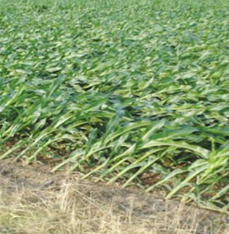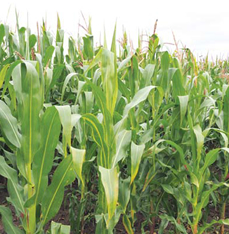Maize Lodging
 Stalk lodging by definition is the breakage of the stalk below the ear. Severely lodged maize leads to increased harvest losses, increased harvest time, increased drying cost and may result in volunteer crops the following year. Lodging in maize crop is as a result of many biotic and abiotic factors.
Stalk lodging by definition is the breakage of the stalk below the ear. Severely lodged maize leads to increased harvest losses, increased harvest time, increased drying cost and may result in volunteer crops the following year. Lodging in maize crop is as a result of many biotic and abiotic factors.
Soil compaction might be the major cause due to the overuse of tractors during land preparation and planting. Soil compaction prevents roots penetration making the crop to be poorly anchored in the soil.
Farmers who experience such challenges should conduct both Pathology and Nutrition Test.
1. Nutrition Test:
• Soil Acidity - It is all known that the soils in Kenya’s maize growing regions like Uasin Gishu are acidic and this results to poor roots growth and development.
• To ascertain the Nitrogen Levels and Potassium Levels – High Nitrogen in relation to potassium levels cause lodging in corns. Potassium imparts resistance to lodging by increasing the rind thickness and crushing strength.
• Silicon and Heavy metals: This include Iron and Aluminium toxicities which interfere with meristimetic tissues of the crop. Silicon has an important role in alleviating the effects and has a major role in anchoring the crop. Silicon maintains higher stomatal conductivity, relative water content and water potential. Silicon shows great influence on the development of plant roots and thicker stems thus allowing better lodging resistance.
2. Pathology Test:
Diseases such as Fusarium Stalk Rot lead to rotting of roots making it susceptible to lodging. Fusarium causes:-
- Rotting at roots, crown and lower internodes.
- Pith disintegrates, vascular bundles remain intact.
- Stalks feel spongy when squeezed and may be easily crushed or crimped at lower internodes • Plants eventually lodge when pushed sideways or impacted by wind.
Points to Note  1. Healthy maize plants that received enough nutrients throughout the season usually do not lodge.
1. Healthy maize plants that received enough nutrients throughout the season usually do not lodge.
The maize plant needs sufficient carbohydrates produced through the process of photosynthesis to fill the root and main stem cells to keep it alive and healthy. It also needs to store enough carbohydrates for the high energy demand during the grain filling stage.
2. When maize experiences any stress during the grain filling stage, photosynthesis is reduced or even temporarily stops.
This reduces the carbohydrates meant for grain filling. The maize plant reacts to this deficiency by extracting stored carbohydrates from the leaves, stems and roots and channels it to the developing kernels. This ‘self-destructive’ process ensures that carbohydrates reach the developing cobs on the plant to the detriment of the stem and roots, which in turn leads to the early death of the stem and roots. This early death of the cells may create the conditions conducive to a fungal infection in the stem and roots of the plant. The first symptom of this is usually only observed when the plant is almost physiologically mature and the lower leaves start to deteriorate. They generally turn yellow as a result of dying off.
3. Other stress factors can also cause stem and root rot.
These include:
- The loss or reduction of leaf surface due to leaf disease (Northern Corn Leaf Blight) and insect damage
- Any damage to the roots caused by insects or chemicals (Group 4 herbicides)
- Imbalances in nutrients, especially high Nitrogen in relation to Potassium levels.
- Soil compaction which can limit root growth.
- A plant population too high for the cultivar or potential of the soil.
4. Most cultivars do not show any signs of stem or root rot right up until just before physiological maturity.
The presence of stem rot, however, does not always cause maize to lodge. It can be avoided by harvesting the infected lands early. Many maize hybrids have very strong stalk walls which contributes to its ability to stay standing even though the core of the stem is destroyed.
5. Damage to the core of the stem is a symptom of all types of stem rot.
It can easily be tested for by flattening the internode between your thumb and forefinger. The plant can also be tested by taking hold of the cob and pressing it approximately 15 cm to 25 cm towards the next row. If the plant bends/breaks between the head and the roots, then stem and root rot is most likely present.
6. To avoid losses due to maize plants falling over, it is important to identify the infected lands as soon as possible for them to be harvested first.
The lands which have experienced drought during the season or those that are infected with Northern Corn Leaf Blight should be the first to be inspected and harvested.
Mr. Timothy Munywoki is an agronomist with Amiran Kenya Ltd